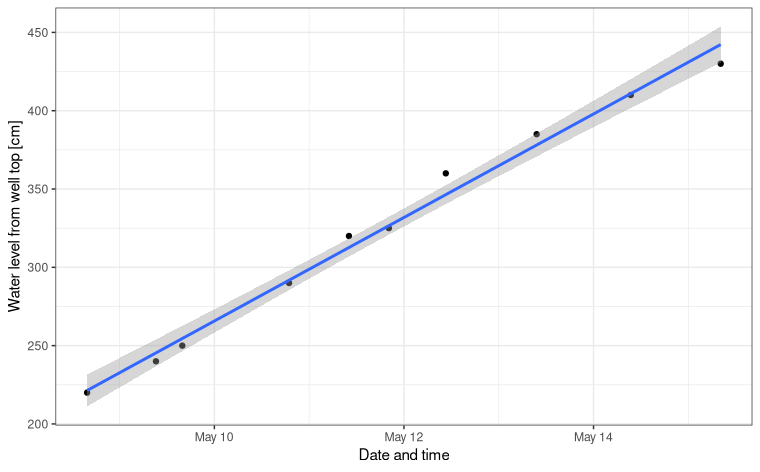The house I live in has been built around 1939 and is accompanied by a water well that is about 6 m deep. This was dug out by hand, 0.5 m a day, added scaffolding, added concrete and so on for a few weeks. I think, but see the below figure where on the right side you can see the jagged ledges that would explain this hypothesis.
In the past (think 1990), this well has been the only source of water for the house, but ever since we've been connected to a public water source, it's been there mostly for show.

Soon we'll be rebuilding the house and rainfall from the roof will have to go somewhere. One of the options is to use this well to siphon the water into. It would be a great feature if the water would flow out of the well so as not to overflow.
In the first week of this May, there was a large rainfall and water level was about 220 cm above the top edge of the well (about 1 m under the surface). This was the ideal opportunity for me to measure how fast the water will go down. Using a tape measure, I measured the distance from the top of the well to the water level with about 5 cm accuracy. It's hard to measure precisely because I could only approximately see when the measurer hit the water level. I noted date and time and wrote it down into a Google Spreadsheet table.
To calculate the rate, I created a (generalized) linear model where I would model water level height as a function of time (seconds). In R parlance, that would be glm(water_level_height ~ time). Summary of the model is
##
## Call:
## glm(formula = razdalja_cm ~ date_time, data = xy)
##
## Deviance Residuals:
## Min 1Q Median 3Q Max
## -12.257 -3.863 -1.472 4.954 13.578
##
## Coefficients:
## Estimate Std. Error t value Pr(>|t|)
## (Intercept) -619585.78740010 22316.13758332 -27.76 0.00000000306 ***
## date_time 0.00038248 0.00001377 27.78 0.00000000304 ***
## ---
## Signif. codes: 0 '***' 0.001 '**' 0.01 '*' 0.05 '.' 0.1 ' ' 1
##
## (Dispersion parameter for gaussian family taken to be 61.77171)
##
## Null deviance: 48160.00 on 9 degrees of freedom
## Residual deviance: 494.17 on 8 degrees of freedom
## AIC: 73.382
##
## Number of Fisher Scoring iterations: 2
If you look at the date_time coefficient, it says that the water level changes 0.00038 cm per second. That makes it about 33 cm a day. The measurements were taken in the span of 6.68 days, so the total lowering of the water level was about 221 cm (calculated backwards from the model). Which is approximately what I measured, starting at 220 cm and ending at 430 cm below water well edge.
To put this into liters, given the diameter of 100 cm, that translates to outflow of 230 L of water per day.
